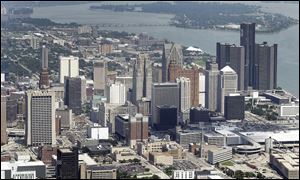
FUTURE AT STAKE
Detroit bankruptcy trial to set course for decade
Case to begin Tuesday in federal court
9/1/2014
In deciding whether Detroit’s plan to exit bankruptcy is equitable, feasible, and in the best interest of creditors, the rarely tested powers and limits of municipal bankruptcy will be spotlighted this week.
DETROIT — In a trial set to open in federal court Tuesday, nothing short of Detroit’s future is at stake.
If Judge Steven Rhodes approves a blueprint drawn up by Detroit officials to eliminate more than $7 billion of its estimated $18 billion in debts and to invest about $1.5 billion into the city’s dismal services, it will mark the beginning of the end of the nation’s largest-ever municipal bankruptcy.
The outcome will set the city’s new course for decades, perhaps longer.
In deciding whether the city’s plan is equitable, feasible, and in the best interest of creditors, Judge Rhodes will send significant messages beyond Detroit about the rarely tested powers and limits of municipal bankruptcy at a time when many cities are struggling with underfunded pensions, neglected infrastructure, and declining industries.
Bankruptcy law has never been tested on this scale.
Other cities’ leaders will watch, turnaround experts said, as the judge decides:
● Whether a city may shelter municipal retirees even as it imposes harsher losses on creditors.
● Whether it can use bankruptcy to repudiate some capital-markets debts entirely.
● Whether a city in bankruptcy may avoid selling off valuable assets to raise money for its creditors, as Detroit hopes to do with its art collection.
For months, as the city’s lawyers struck deals during mediation with retirees and other creditors, Detroit’s passage through bankruptcy has gained momentum.
The progress has raised the possibility that after seeking bankruptcy protection just one year ago, Detroit might emerge with relative ease and remarkable speed, by fall.
Yet, as Judge Rhodes prepares to hear what is expected to be more than a month of testimony on the city’s blueprint, serious impediments and numerous unknowns remain.
In voting that is part of the bankruptcy process, majorities of six classes of the city’s creditors cast ballots in favor of the city’s plan in recent months, but five other voting classes rejected it.
Some opponents, including the bond insurers Syncora and Financial Guaranty, have fought the plan, saying it improperly favors some creditors over others and uses a questionable transaction to put the riches of the art collection beyond the creditors’ reach.
Syncora went so far as to file an objection calling the plan “a quasi-political maneuver” hatched by the chief mediator of the bankruptcy, Gerald Rosen, who Syncora said was biased in favor of Detroit’s retirees.
Judge Rosen also is the chief judge of the U.S. District Court for the Eastern District of Michigan, the seat of the bankruptcy court.
Last week, Judge Rhodes called Syncora’s accusations “manifestly improper and false” and ordered them stricken from the court record.
Beyond those problems, Judge Rhodes must grapple with larger questions: Even if the city’s debt-cutting answers Detroit’s immediate financial crisis, will it go far enough to prevent the city from sliding back into overwhelming debt, annual operating deficits, and the threat of default and another bankruptcy in the years ahead?
And will new spending to improve firefighting, police protection, and archaic computer technology, and to remove tens of thousands of dilapidated buildings, be enough to restore city services and stop decades of decline?
Under the plan the city hopes Judge Rhodes will confirm, Detroit’s more than 100,000 creditors would get a wide range of returns on their claims.
Investors who bought $1.4 billion of certificates the city issued in 2005, to raise money for its pension system, could come away nearly empty-handed.
By contrast, investors who bought a type of general obligation bond that was backed by a special, dedicated tax are to recover 74 cents on the dollar.
Thousands of retirees from the city’s fire and police departments would expect no cuts to monthly pension checks, but smaller than expected cost-of-living increases in future years.
General municipal retirees could see 4.5 percent cuts to their monthly pension checks, an end to cost-of-living increases, and a clawback of previous payments from the pension system that are now deemed to have been improper.
The more desirable outcomes for workers and retirees are possible with a separate, newly pledged pot of money: hundreds of millions of dollars from foundations, the state, and other donors in an unusual, mediated deal called the Grand Bargain, to raise fresh money for the pension system and protect from sale the works of the Detroit Institute of Arts.